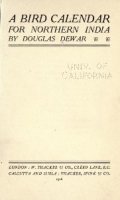Dewar’s Calendar — October
October is a season when autumnal migrants flood the Indian subcontinent. Douglas Dewar beautifully summarises this month in his A Bird Calendar for Northern India, published in 1916.
| October in India differs from the English month in almost every respect…In England autumn is the season for the departure of the migratory birds; in India it is the time of their arrival…In many ways the autumn season in Northern India resembles the English spring. The Indian October may be likened to April in England. Both are months of hope, heralds of the most pleasant period of the year. In both the countryside is fresh and green. In both millions of avian visitors arrive.
It is good to ride forth on an October morn with the object of renewing acquaintance with nimble wagtails, sprightly redstarts, stately demoiselle cranes and other newly-returned migrants. Migration and moulting are the chief events in the feathered world at the present season. The flood of autumn immigration, which arose as a tiny stream in August, and increased in volume nightly throughout September, becomes, in October, a mighty river on the bosom of which millions of birds are borne. Day by day the avian population of the jhils increases. At the beginning of the month the garganey teal are almost the only migratory ducks to be seen on them. By the first of November brahminy duck, gadwall, common teal, widgeon, shovellers and the various species of pochard abound. With the duck come demoiselle cranes, curlews, storks, and sandpipers of various species. The geese and the pintail ducks, however, do not return to India until November. These are the last of the regular winter visitors to come and the first to go. The various kinds of birds of prey which began to appear in September continue to arrive throughout the present month. Grey-headed and red-breasted flycatchers, minivets, bush-chats, rose-finches and swallows pour into the plains from the Himalayas, while from beyond those mountains come redstarts, wagtails, starlings, buntings, blue-throats, quail and snipe. Along with the other migrants come numbers of rooks and jackdaws. These do not venture far into India; they confine themselves to the North-West Frontier Province and the Punjab, where they remain during the greater part of the winter. The exodus, from the above-mentioned Provinces, of the bee-eaters, sunbirds, yellow-throated sparrows, orioles, red turtle-doves and paradise flycatchers is complete by the end of October. The above are by no means the only birds that undergo local migration. The great majority of species probably move about in a methodical manner in the course of the year; a great deal of local migration is overlooked, because the birds that move away from a locality are replaced by others of their kind that come from other places. |
Taken, with grateful thanks, from Project Gutenberg.

